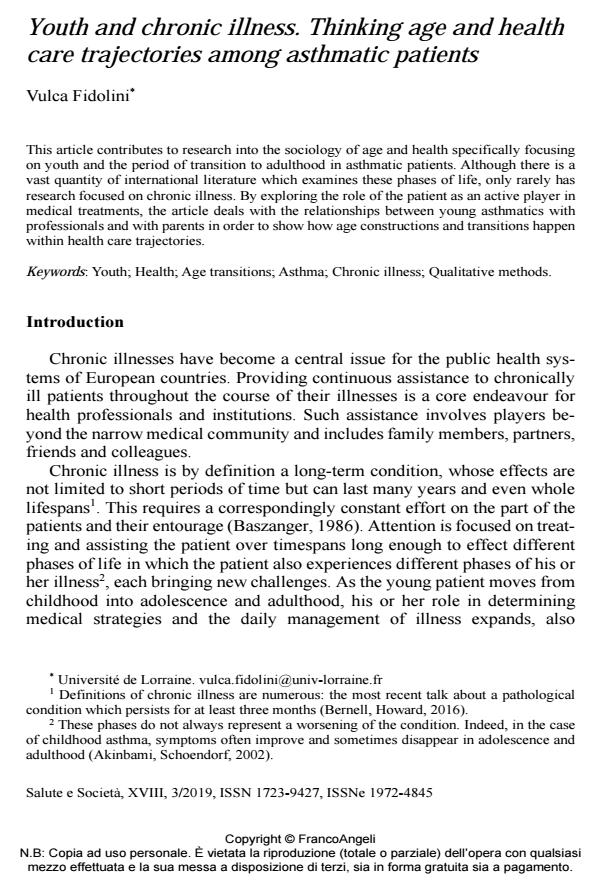Youth and chronic illness. Thinking age and health care trajectories among asthmatic patients
Journal title SALUTE E SOCIETÀ
Author/s Vulca Fidolini
Publishing Year 2019 Issue 2019/3 Language English
Pages 13 P. 59-71 File size 216 KB
DOI 10.3280/SES2019-003006
DOI is like a bar code for intellectual property: to have more infomation
click here
Below, you can see the article first page
If you want to buy this article in PDF format, you can do it, following the instructions to buy download credits

FrancoAngeli is member of Publishers International Linking Association, Inc (PILA), a not-for-profit association which run the CrossRef service enabling links to and from online scholarly content.
This article contributes to research into the sociology of age and health specifically focusing on youth and the period of transition to adulthood in asthmatic patients. Although there is a vast quantity of international literature which examines these phases of life, only rarely has research focused on chronic illness. By exploring the role of the patient as an active player in medical treatments, the article deals with the relationships between young asthmatics with profession-als and with parents in order to show how age constructions and transitions happen within health care trajectories.
Keywords: Youth; Health; Age transitions; Asthma; Chronic illness; Qualitative methods.
- Strauss A.L. (1987). Qualitative analysis for social scientists. New York: Cambridge University Press.
- Thiercé A. (1999). Histoire de l’adolescence (1850-1914). Paris: Belin.
- Van de Velde C. (2008). Devenir adulte. Sociologie comparée de la jeunesse en Europe. Paris: PUF.
- Strauss A.L., Glaser B.G. (1975). Chronic illness and the quality of life. Saint-Louis: C.V. Mosby Co.
- Stellinger A., editor (2008). Les jeunesses face à leur avenir. Une enquête internationale. Paris: Fondation pour l’innovation politique.
- Rosenfeld M.J. (2007). The age of independence: Interracial unions, samesex unions and the changing American family. Cambridge, MA: Harvard University Press.
- Guizzardi L. (2007). La transizione all’età adulta. Teorie sociologiche a confronto. Milan: LED.
- Galland O. (2009). Les jeunes. Paris: La Découverte.
- Furlong A., Cartmel F. (1997). Young People and Social Change. Individualisation and Risk in Late Modernity. Buckingham: Open University Press.
- Fidolini V. (2017). Heteromasculinities. Sexual Experiences and Transition to Adulthood among Young Moroccan Men in Europe. Men and Masculinities, First Published October 23, 2017. DOI: 10.1177/1097184X1773260
- Favretto A.R., Fucci S., Zaltron F. (2017). Con gli occhi dei bambini. Come l’infanzia affronta la malattia. Bologna: il Mulino.
- Eckert E. (2010). Les jeunes, les études, le travail, l’autonomie… In: Hamel J., Pugeault-Cicchelli C., Galland C., Cicchelli V., editors, La jeunesse n’est plus ce qu’elle était. Rennes: PUR.
- Diasio N., Vinel V. (2014). La préadolescence: un nouvel âge de la vie?. Revue des sciences sociales, 51: 8-13.
- Cresson G. (2006). La production familiale de soins et de santé. La prise en compte tardive et inachevée d’une participation essentielle. Recherches familiales, 3: 6-15. DOI: 10.3917/rf.003.0006
- Cozzi D., Diasio N. (2017). Embodying illness and managing the uncertainty. Miscellanea Anthropologica et Sociologica, 18(3): 50-64.
- Corijin M., Klijzing E. (2001). Transitions to Adulthood in Europe. Dordrecht: Kluwer Academic Publishers.
- Charmaz K. (2000). Experiencing chronic illness. In: Albrecht G.L., Fitzpatrick R., Scrimshaw S.C., editors, The handbook of social studies in health and medicine. London: Sage Publications.
- Cavalli A., Galland O. (1993). L’allongement de la jeunesse. Arles: Actes sud.
- Buchmann M.C., Kriesi I. (2011). Transition to adulthood in Europe. Annual Review of Sociology, 37: 481-503.
- Bessin M. (2002). Les transformations des rites de la jeunesse. Agora débats/jeunesses, 28: 12-20.
- Bernell S., Howard S.W. (2016). Use Your Words Carefully: What Is a Chronic Disease?. Front Public Health, 4: 159.
- Baszanger I. (1986). Les maladies chroniques et leur ordre négocié. Revue française de sociologie, 27(1): 3-27.
- Armstrong D. (2014). Actors, patients and agency: a recent history. Sociology of Health & Illness, 36(2): 163-74. DOI: 10.1111/1467-9566.12100
- Armstrong D. (1995). The rise of surveillance medicine. Sociology of Health & Illness, 17(3): 393-404.
- Anderson R., Bury M., editors (1988). Living with chronic illness. The experience of patients and their families. London: Unwin Hyman.
- Akinbami L.J., Schoendorf K.C. (2002). Trends in childhood asthma: prevalence, health care utilization, and mortality. Pediatrics, 110: 315-322.
- Achin C., Ouardi S., Rennes J. (2009). Âge, intersectionnalité, rapports de pouvoir. Mouvements, 3(59): 91-101.
- Parcours de décohabitation et maladie chronique Vulca Fidolini, in Agora débats/jeunesses /2023 pp.23
DOI: 10.3917/agora.093.0023
Vulca Fidolini, Youth and chronic illness. Thinking age and health care trajectories among asthmatic patients in "SALUTE E SOCIETÀ" 3/2019, pp 59-71, DOI: 10.3280/SES2019-003006